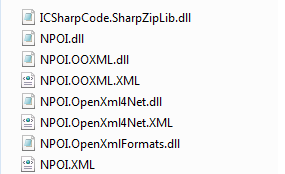在.net中,常用的操作excel文件的方式,有三种: OLE DB的形式, 第三方框架NPOI, Office组件。
总结: 通过对比,在读取大数据量的excel文件,建议用OLE DB的形式,把excel文件当作数据源,效率比较高。
1. 用OLE DB 方法
public static DataTable CreateDataTable(string excelFileName, string sheetName)
{
DataTable dt = new DataTable();
try
{
//For ".xlsx" excel file.
//oleDbConnection = new OleDbConnection("provider=Microsoft.ACE.OLEDB.12.0; Data Source='" + files[0] + "'" + "; Extended Properties='Excel 8.0;HDR=No;IMEX=1;'");
using (OleDbConnection oleDbConnection = new OleDbConnection("Provider=Microsoft.Jet.OLEDB.4.0; Data Source='" + excelFileName + "'" + "; Extended Properties= 'Excel 8.0;HDR=No;IMEX=1;'"))
{
OleDbDataAdapter oleDbAdapter = new OleDbDataAdapter("select * from [" + sheetName + "]", oleDbConnection);
oleDbAdapter.Fill(dt);
}
return dt;
}
catch (Exception ex)
{
throw new Exception(string.Format("CreateDataTable Function error for : {0}", ex.Message));
}
}
2. 用NPOI 方法
public static DataTable CreateDataTableByNPOI(string excelFileName, string sheetName)
{
DataTable dt = new DataTable();
IWorkbook workbook = null;
ISheet sheet = null;
try
{
string prefix = excelFileName.Substring(excelFileName.IndexOf('.')).ToLower();
using (FileStream fs = new FileStream(excelFileName, FileMode.Open, FileAccess.Read))
{
if (prefix == ".xls")
{
workbook = new HSSFWorkbook(fs);
}
else if (prefix == ".xlsx")
{
workbook = new XSSFWorkbook(fs);
}
}
sheet = workbook.GetSheet(sheetName);
if (sheet != null)
{
IRow firstRow = sheet.GetRow(0);
int cellCount = firstRow.LastCellNum;
for (int i = firstRow.FirstCellNum; i < cellCount; i++)
{
ICell cell = firstRow.GetCell(i);
if (cell != null)
{
string cellValue = cell.StringCellValue;
if (cellValue != null)
{
DataColumn column = new DataColumn(cellValue);
dt.Columns.Add(column);
}
}
}
for (int i = sheet.FirstRowNum + 1; i <= sheet.LastRowNum; i++)
{
IRow row = sheet.GetRow(i);
if (row == null)
{
continue;
}
DataRow dataRow = dt.NewRow();
for (int j = row.FirstCellNum; j < cellCount; ++j)
{
if (row.GetCell(j) != null)
{
dataRow[j] = row.GetCell(j).ToString();
}
}
dt.Rows.Add(dataRow);
}
}
return dt;
}
catch (Exception ex)
{
throw new Exception(string.Format("CreateDataTableByNPOI Function error for : {0}", ex.Message));
}
finally
{
workbook.Close();
}
}
注意: 要引入NPOI 相关的DLL文件。
